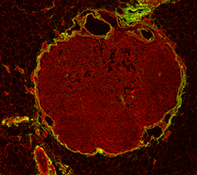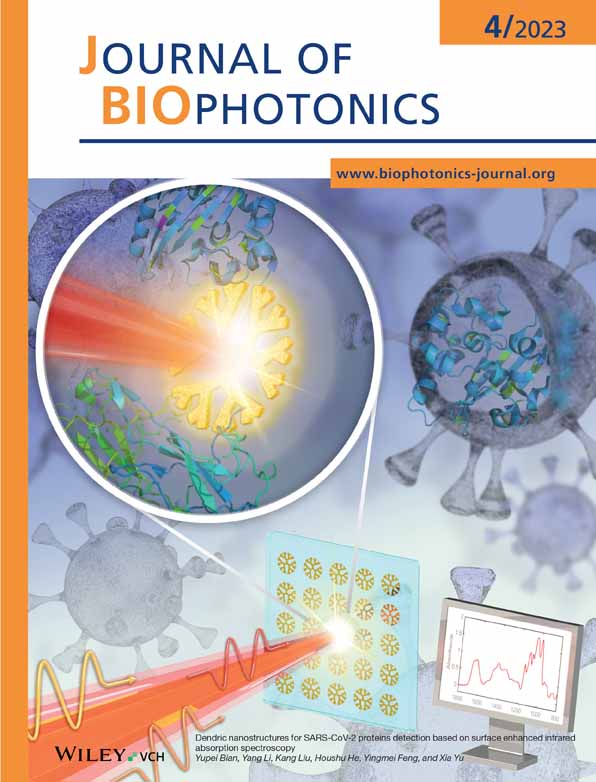Detection of pathological response of axillary lymph node metastasis after neoadjuvant chemotherapy in breast cancer using multiphoton microscopy
Zhonghua Han
Department of Breast Surgery, Fujian Medical University Union Hospital, Fuzhou, China
Department of General Surgery, Fujian Medical University Union Hospital, Fuzhou, China
Breast Cancer Institute, Fujian Medical University, Fuzhou, China
Search for more papers by this authorXingxin Huang
Key Laboratory of OptoElectronic Science and Technology for Medicine of Ministry of Education, Fujian Provincial Key Laboratory for Photonics Technology, Fujian Normal University, Fuzhou, China
Search for more papers by this authorDeyong Kang
Department of Pathology, Fujian Medical University Union Hospital, Fuzhou, China
Search for more papers by this authorFangmeng Fu
Department of Breast Surgery, Fujian Medical University Union Hospital, Fuzhou, China
Department of General Surgery, Fujian Medical University Union Hospital, Fuzhou, China
Breast Cancer Institute, Fujian Medical University, Fuzhou, China
Search for more papers by this authorShichao Zhang
Key Laboratory of OptoElectronic Science and Technology for Medicine of Ministry of Education, Fujian Provincial Key Laboratory for Photonics Technology, Fujian Normal University, Fuzhou, China
Search for more papers by this authorZhenlin Zhan
Key Laboratory of OptoElectronic Science and Technology for Medicine of Ministry of Education, Fujian Provincial Key Laboratory for Photonics Technology, Fujian Normal University, Fuzhou, China
Search for more papers by this authorJianxin Chen
Key Laboratory of OptoElectronic Science and Technology for Medicine of Ministry of Education, Fujian Provincial Key Laboratory for Photonics Technology, Fujian Normal University, Fuzhou, China
Search for more papers by this authorCorresponding Author
Lianhuang Li
Key Laboratory of OptoElectronic Science and Technology for Medicine of Ministry of Education, Fujian Provincial Key Laboratory for Photonics Technology, Fujian Normal University, Fuzhou, China
Correspondence
Lianhuang Li, Fujian Normal University, Fuzhou 350007, China.
Email: [email protected]
Chuan Wang, Fujian Medical University Union Hospital, Fuzhou 350001, China.
Email: [email protected]
Search for more papers by this authorCorresponding Author
Chuan Wang
Department of Breast Surgery, Fujian Medical University Union Hospital, Fuzhou, China
Department of General Surgery, Fujian Medical University Union Hospital, Fuzhou, China
Breast Cancer Institute, Fujian Medical University, Fuzhou, China
Correspondence
Lianhuang Li, Fujian Normal University, Fuzhou 350007, China.
Email: [email protected]
Chuan Wang, Fujian Medical University Union Hospital, Fuzhou 350001, China.
Email: [email protected]
Search for more papers by this authorZhonghua Han
Department of Breast Surgery, Fujian Medical University Union Hospital, Fuzhou, China
Department of General Surgery, Fujian Medical University Union Hospital, Fuzhou, China
Breast Cancer Institute, Fujian Medical University, Fuzhou, China
Search for more papers by this authorXingxin Huang
Key Laboratory of OptoElectronic Science and Technology for Medicine of Ministry of Education, Fujian Provincial Key Laboratory for Photonics Technology, Fujian Normal University, Fuzhou, China
Search for more papers by this authorDeyong Kang
Department of Pathology, Fujian Medical University Union Hospital, Fuzhou, China
Search for more papers by this authorFangmeng Fu
Department of Breast Surgery, Fujian Medical University Union Hospital, Fuzhou, China
Department of General Surgery, Fujian Medical University Union Hospital, Fuzhou, China
Breast Cancer Institute, Fujian Medical University, Fuzhou, China
Search for more papers by this authorShichao Zhang
Key Laboratory of OptoElectronic Science and Technology for Medicine of Ministry of Education, Fujian Provincial Key Laboratory for Photonics Technology, Fujian Normal University, Fuzhou, China
Search for more papers by this authorZhenlin Zhan
Key Laboratory of OptoElectronic Science and Technology for Medicine of Ministry of Education, Fujian Provincial Key Laboratory for Photonics Technology, Fujian Normal University, Fuzhou, China
Search for more papers by this authorJianxin Chen
Key Laboratory of OptoElectronic Science and Technology for Medicine of Ministry of Education, Fujian Provincial Key Laboratory for Photonics Technology, Fujian Normal University, Fuzhou, China
Search for more papers by this authorCorresponding Author
Lianhuang Li
Key Laboratory of OptoElectronic Science and Technology for Medicine of Ministry of Education, Fujian Provincial Key Laboratory for Photonics Technology, Fujian Normal University, Fuzhou, China
Correspondence
Lianhuang Li, Fujian Normal University, Fuzhou 350007, China.
Email: [email protected]
Chuan Wang, Fujian Medical University Union Hospital, Fuzhou 350001, China.
Email: [email protected]
Search for more papers by this authorCorresponding Author
Chuan Wang
Department of Breast Surgery, Fujian Medical University Union Hospital, Fuzhou, China
Department of General Surgery, Fujian Medical University Union Hospital, Fuzhou, China
Breast Cancer Institute, Fujian Medical University, Fuzhou, China
Correspondence
Lianhuang Li, Fujian Normal University, Fuzhou 350007, China.
Email: [email protected]
Chuan Wang, Fujian Medical University Union Hospital, Fuzhou 350001, China.
Email: [email protected]
Search for more papers by this authorAbstract
Neoadjuvant treatment is often considered in breast cancer patients with axillary lymph node involvement, but most of patients do not have a pathologic complete response to therapy. The detection of residual nodal disease has a significant impact on adjuvant therapy recommendations which may improve survival. Here, we investigate whether multiphoton microscopy (MPM) could identify the pathological changes of axillary lymphatic metastasis after neoadjuvant chemotherapy in breast cancer. And furthermore, we find that there are obvious differences in seven collagen morphological features between normal node and residual axillary disease by combining with a semi-automatic image processing method, and also find that there are significant differences in four collagen features between the effective and no-response treatment groups. These research results indicate that MPM may help estimate axillary treatment response in the neoadjuvant setting and thereby tailor more appropriate and personalized adjuvant treatments for breast cancer patients.
CONFLICT OF INTEREST
The authors declare that they have no conflict of interest.
Open Research
DATA AVAILABILITY STATEMENT
No data
REFERENCES
- 1V. Murthy, J. Young, Y. Tokumaru, M. Quinn, S. B. Edge, K. Takabe, Cancers 2021, 13, 4167.
- 2S. Samiei, J. M. Simons, S. M. E. Engelen, R. G. H. Beets-Tan, J. M. Classe, M. L. Smidt, E. Group, JAMA Surg 2021, 156, e210891.
- 3R. Kim, J. M. Chang, H. B. Lee, S. H. Lee, S. Y. Kim, E. S. Kim, N. Cho, W. K. Moon, Radiology 2019, 293, 49.
- 4H. L. Chung, H. T. Le-Petross, J. W. T. Leung, Radiographics 2021, 41, 1283.
- 5H. Abe, Radiology 2021, 300, 55.
- 6L. T. Qu, S. Peters, A. N. Cobb, C. V. Godellas, C. B. Perez, F. T. Vaince, Am J Surg 2018, 215, 530.
- 7I. Skarping, D. Fornvik, S. Zackrisson, S. Borgquist, L. Ryden, Breast Cancer Res Treat 2021, 189, 131.
- 8B. Shen, S. Liu, Y. Li, Y. Pan, Y. Lu, R. Hu, J. Qu, L. Liu, Light: Sci Appl 2022, 11, 76.
- 9S. You, H. Tu, E. J. Chaney, Y. Sun, Y. Zhao, A. J. Bower, Y. Z. Liu, M. Marjanovic, S. Sinha, Y. Pu, S. A. Boppart, Nat Commun 2018, 9, 2125.
- 10W. Zong, R. Wu, S. Chen, J. Wu, H. Wang, Z. Zhao, G. Chen, R. Tu, D. Wu, Y. Hu, Y. Xu, Y. Wang, Z. Duan, H. Wu, Y. Zhang, J. Zhang, A. Wang, L. Chen, H. Cheng, Nat Methods 2021, 18, 46.
- 11B. L. Sprague, P. M. Vacek, S. E. Mulrow, M. F. Evans, A. Trentham-Dietz, S. D. Herschorn, T. A. James, N. Surachaicharn, A. Keikhosravi, K. W. Eliceiri, D. L. Weaver, M. W. Conklin, Cancer Epidemiol, Biomarkers Prev 2021, 30, 80.
- 12T. Matsui, R. Tamoto, A. Iwasa, M. Mimura, S. Taniguchi, T. Hasegawa, T. Sudo, H. Mizuno, J. Kikuta, I. Onoyama, K. Okugawa, M. Shiomi, S. Matsuzaki, E. Morii, T. Kimura, K. Kato, Y. Kiyota, M. Ishii, Cancer Res 2020, 80, 3745.
- 13G. Xi, L. Qiu, S. Xu, W. Guo, F. Fu, D. Kang, L. Zheng, J. He, Q. Zhang, L. Li, C. Wang, J. Chen, BMC Med 2021, 19, 273.
- 14L. Li, Z. Han, L. Qiu, D. Kang, Z. Zhan, H. Tu, J. Chen, Int J Biol Sci 2020, 16, 1376.
- 15L. Li, Z. Chen, X. Wang, X. Liu, W. Jiang, S. Zhuo, G. Guan, J. Chen, IEEE J Sel Top Quantum Electron 2016, 22, 6800206.
- 16A. P. Dempster, N. M. Laird, D. B. Rubin, J R Stat Soc Series B (Methodol) 1977, 39, 1.
10.1111/j.2517-6161.1977.tb01600.x Google Scholar
- 17L. H. Li, Z. H. Han, L. D. Qiu, D. Y. Kang, Z. L. Zhan, H. H. Tu, J. X. Chen, J Biophotonics 2020, 13, e201900216.
- 18L. Li, Z. Chen, X. Wang, S. Zhuo, H. Li, W. Jiang, G. Guan, J. Chen, J Biomed Opt 2015, 20, 051009.
- 19J. C. Boughey, V. J. Suman, E. A. Mittendorf, G. M. Ahrendt, L. G. Wilke, B. Taback, A. M. Leitch, H. M. Kuerer, M. Bowling, T. S. Flippo-Morton, D. R. Byrd, D. W. Ollila, T. B. Julian, S. A. McLaughlin, L. McCall, W. F. Symmans, H. T. Le-Petross, B. G. Haffty, T. A. Buchholz, H. Nelson, K. K. Hunt, JAMA 2013, 310, 1455.
- 20N. Goel, S. Yadegarynia, S. Rodgers, K. Kelly, A. Collier, D. Franceschi, M. Moller, E. Avisar, S. B. Kesmodel, J Surg Oncol 2021, 124, 25.
- 21S. Al-Hattali, S. J. Vinnicombe, N. M. Gowdh, A. Evans, S. Armstrong, D. Adamson, C. A. Purdie, E. J. Macaskill, Cancer Imaging 2019, 19, 91.
- 22G. Xi, W. Guo, D. Kang, J. Ma, F. Fu, L. Qiu, L. Zheng, J. He, N. Fang, J. Chen, J. Li, S. Zhuo, X. Liao, H. Tu, L. Li, Q. Zhang, C. Wang, S. A. Boppart, J. Chen, Theranostics 2021, 11, 3229.
- 23P. P. Provenzano, K. W. Eliceiri, J. M. Campbell, D. R. Inman, J. G. White, P. J. Keely, BMC Med 2006, 4, 38.
- 24P. P. Provenzano, D. R. Inman, K. W. Eliceiri, J. G. Knittel, L. Yan, C. T. Rueden, J. G. White, P. J. Keely, BMC Med 2008, 6, 11.
- 25S. Cao, X. Liu, J. Cui, X. Liu, J. Zhong, Z. Yang, D. Sun, W. Wei, Breast 2021, 59, 256.
- 26N. Klauber-DeMore, D. W. Ollila, D. T. Moore, C. Livasy, B. F. Calvo, H. J. Kim, E. C. Dees, C. I. Sartor, L. R. Sawyer, M. Graham 2nd, L. A. Carey, Ann Surg Oncol 2006, 13, 685.
- 27G. M. Baker, T. A. King, S. J. Schnitt, Adv Anat Pathol 2019, 26, 221.
- 28Y. K. Tao, D. Shen, Y. Sheikine, O. O. Ahsen, H. H. Wang, D. B. Schmolze, N. B. Johnson, J. S. Brooker, A. E. Cable, J. L. Connolly, J. G. Fujimoto, PNAS 2014, 111, 15304.
- 29T. Yoshitake, M. G. Giacomelli, L. C. Cahill, D. B. Schmolze, H. Vardeh, B. E. Faulkner-Jones, J. L. Connolly, J. G. Fujimoto, J Biomed Opt 2016, 21, 126021.
- 30L. Qiu, D. Kang, C. Wang, W. Guo, F. Fu, Q. Wu, G. Xi, J. He, L. Zheng, Q. Zhang, X. Liao, L. Li, J. Chen, H. Tu, Nat Commun 2022, 13, 4250.
- 31I. Acerbi, L. Cassereau, I. Dean, Q. Shi, A. Au, C. Park, Y. Y. Chen, J. Liphardt, E. S. Hwang, V. M. Weaver, Integr Biol 2015, 7, 1120.
- 32L. Gole, J. Yeong, J. C. T. Lim, K. H. Ong, H. Han, A. A. Thike, Y. C. Poh, S. Yee, J. Lqbal, W. J. Hong, B. Lee, W. M. Yu, P. H. Tan, Breast Cancer Res 2020, 22, 42.
- 33A. H. Beck, A. R. Sangoi, S. Leung, R. J. Marinelli, T. O. Nielsen, M. J. van de Vijver, R. B. West, M. van de Rijn, D. Koller, Sci Transl Med 2011, 3, 108ra113.
- 34L. Jiang, C. You, Y. Xiao, H. Wang, G. H. Su, B. Q. Xia, R. C. Zheng, D. D. Zhang, Y. Z. Jiang, Y. J. Gu, Z. M. Shao, Cell Rep Med 2022, 3, 100694.
- 35Y. Sun, S. You, H. Tu, D. R. Spillman Jr., E. J. Chaney, M. Marjanovic, J. Li, R. Barkalifa, J. Wang, A. M. Higham, N. N. Luckey, K. A. Cradock, Z. George Liu, S. A. Boppart, Sci Adv 2018, 4, eaau5603.




